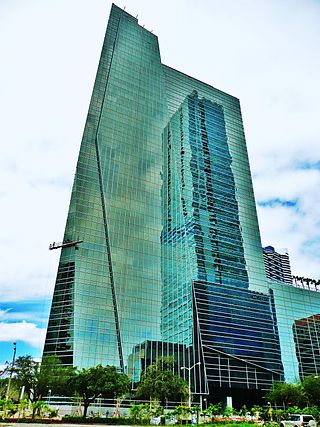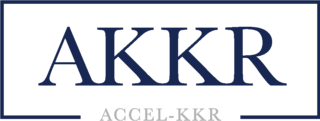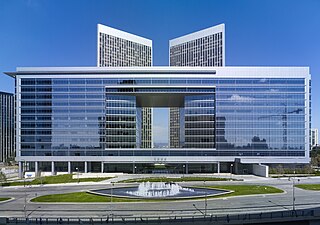
A leveraged buyout (LBO) is one company's acquisition of another company using a significant amount of borrowed money (leverage) to meet the cost of acquisition. The assets of the company being acquired are often used as collateral for the loans, along with the assets of the acquiring company. The use of debt, which normally has a lower cost of capital than equity, serves to reduce the overall cost of financing the acquisition. The cost of debt is lower because interest payments often reduce corporate income tax liability, whereas dividend payments normally do not. This reduced cost of financing allows greater gains to accrue to the equity, and, as a result, the debt serves as a lever to increase the returns to the equity.
The Carlyle Group is a multinational private equity, alternative asset management and financial services corporation based in the United States with $376 billion of assets under management. It specializes in private equity, real assets, and private credit. It is one of the largest mega-funds in the world. In 2015, Carlyle was the world's largest private equity firm by capital raised over the previous five years, according to the PEI 300 index. In the 2023 ranking however, it had slipped to fifth place.

KKR & Co. Inc., also known as Kohlberg Kravis Roberts & Co., is an American global investment company that manages multiple alternative asset classes, including private equity, energy, infrastructure, real estate, credit, and, through its strategic partners, hedge funds. As of December 31, 2022, the firm had completed more than 690 private equity investments in portfolio companies with approximately $700 billion of total enterprise value. As of December 31, 2022, assets under management (AUM) and fee paying assets under management (FPAUM) were $504 billion and $412 billion, respectively.
Thomas H. Lee Partners, L.P. is an American private equity firm based in Boston. Investing in middle market growth companies across financial technology, services, healthcare, technology, & business solutions.

Apollo Global Management, Inc. is an American global private equity firm. Founded in 1990 by Leon Black, Josh Harris, and Marc Rowan, it provides investment management and invests in credit, private equity, and real assets. As of 2022, the company had $548 billion of assets under management, including $392 billion invested in credit, including mezzanine capital, hedge funds, non-performing loans, and collateralized loan obligations, $99 billion invested in private equity, and $46.2 billion invested in real assets, which includes real estate and infrastructure. The company invests money on behalf of pension funds, financial endowments, and sovereign wealth funds, as well as other institutional and individual investors. Funds managed by Apollo have produced a 24% internal rate of return (IRR) to investors, net of fees.
A Business Development Company ("BDC") is a form of unregistered closed-end investment company in the United States that invests in small and mid-sized businesses. This form of company was created by the US Congress in 1980 in the amendments to the Investment Company Act of 1940. Publicly filing firms may elect regulation as BDCs if they meet certain requirements of the Investment Company Act.

The history of private equity and venture capital and the development of these asset classes has occurred through a series of boom-and-bust cycles since the middle of the 20th century. Within the broader private equity industry, two distinct sub-industries, leveraged buyouts and venture capital experienced growth along parallel, although interrelated tracks.

Angelo, Gordon & Co. L.P. is a global alternative investment manager founded in November 1988 by John M. Angelo and Michael L. Gordon who together ran the arbitrage department of L.F. Rothschild in the 1980s.

H.I.G. Capital is a Miami, Florida–based private equity and alternative assets investment firm with $56 billion of equity capital under management. The firm operates a family of private equity, growth equity, credit/special situation, primary lending, syndicated credit, and real estate funds. The company provides both debt and equity capital to small and mid-sized companies.

Thoma Bravo, LP, is an American private equity and growth capital firm with offices in San Francisco, Chicago and Miami. It is known for being particularly active in acquiring software companies and has over $120 billion in assets under management. It is the successor to the firm Golder Thoma & Co., which was established in 1980 by Stanley Golder and Carl Thoma. Thoma Bravo is led by managing partners Seth Boro, Orlando Bravo, Scott Crabill, Lee Mitchell, Holden Spaht and Carl Thoma.

Private equity in the 1990s relates to one of the major periods in the history of private equity and venture capital. Within the broader private equity industry, two distinct sub-industries, leveraged buyouts and venture capital, experienced growth along parallel although interrelated tracks.

Private equity in the 2000s represents one of the major growth periods in the history of private equity and venture capital. Within the broader private equity industry, two distinct sub-industries, leveraged buyouts and venture capital expanded along parallel and interrelated tracks.
Publicly traded private equity refers to an investment firm or investment vehicle, which makes investments conforming to one of the various private equity strategies, and is listed on a public stock exchange.

Accel-KKR is an American technology-focused private equity firm with over $14 billion in total assets under management. The firm invests primarily in middle-market software and technology-enabled services businesses, providing capital for buyouts and growth investments across a range of opportunities, including recapitalization, divisional carve-outs, and going-private transactions. The company has offices in Menlo Park, California, (headquarters), Atlanta, Georgia, Mexico City, and London.

Ares Management Corporation is a global alternative investment manager operating in the credit, private equity and real estate markets. The company was founded in 1997 with additional offices across North America, Europe, and Asia.

Vista Equity Partners is one of the largest American private equity firms focused on financing software, data, and technology-enabled businesses. Vista has invested in hundreds of companies, including Citrix, Ping Identity, and Marketo.
Lawrence E. Golub is an American entrepreneur, philanthropist, and business executive. He is the CEO of Golub Capital, a credit asset management company he founded in 1994. Prior to Golub Capital, he had management careers with Bankers Trust Company and Allen & Company. Golub sits on the board of numerous organizations, including American Repertory Theater and Harvard University's JD-MBA Alumni Association. He is one of three private members of the Financial Control Board of the State of New York.
David B. Golub is an American businessman. He is the CEO of publicly traded Golub Capital BDC, and president of its parent company Golub Capital. Golub is the chairman and director of The Michael J. Fox Foundation.

American Capital, Ltd. was a publicly traded private equity and global asset management firm, trading on NASDAQ under the symbol “ACAS” from 1997 to 2017 and a component of the S&P 500 Index from 2007 to 2009. American Capital was sold to Ares Management in 2017 at a sale price that totaled $4.1 billion. For those investors who bought American Capital stock in its August 29, 1997 IPO, and held their shares through the sale of American Capital on January 3, 2017, they received a 14% compounded annual return including dividends.
Unitranche debt is a form of flexible financing, typically used to fund mid-size buyouts and acquisitions. Unitranche financing is structured differently from other loan types since there is only one tranche, rather than more traditional loans which may prioritize senior debt over subordinated debt.










